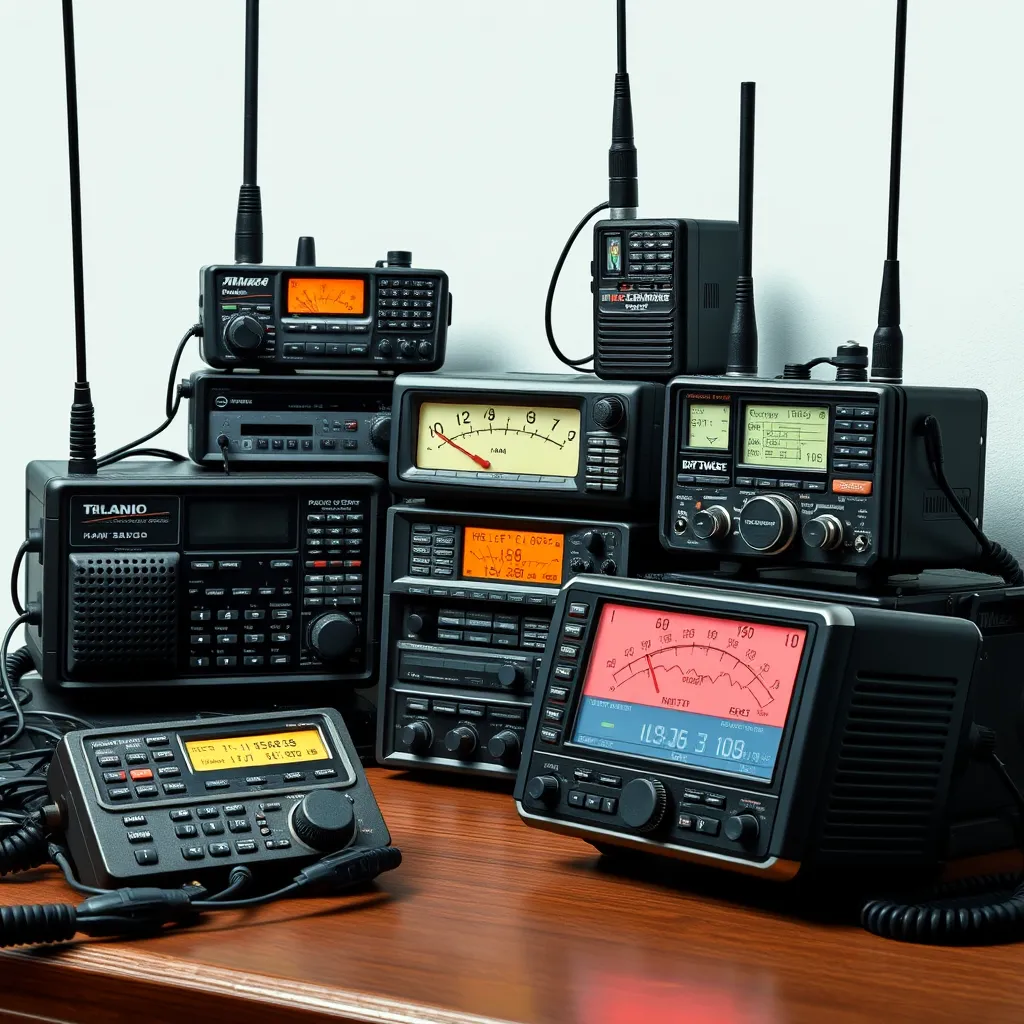
Introduction to Ham Radios
Ham radios, also known as amateur radios, represent a unique segment of radio communication that is both engaging and practical. These devices are operated by licensed enthusiasts who utilize radio frequencies for non-commercial purposes. The concept of amateur radio dates back to the early 20th century, when technological advancements allowed individuals to experiment with transmitting and receiving signals. The significance of ham radios has only grown over the years, particularly in their ability to provide reliable communication during emergencies and natural disasters.
Historically, ham radios emerged as a means for individuals to connect and share information without relying on commercial telecommunication services. As the popularity of radio technology soared, amateur radio operators began to form communities based on shared interests, leading to the establishment of organized events and contests. The resilience of ham radio in times of crisis is particularly noteworthy; during emergencies when traditional communication systems fail, ham radios serve as vital tools for relaying information, mobilizing assistance, and maintaining contact.
Ham radios operate across various bands and frequencies, spanning from HF (High Frequency) to VHF (Very High Frequency) and UHF (Ultra High Frequency). Each band offers unique capabilities and is used for specific purposes, from local communication to reaching international stations. The extensive range of frequencies available allows operators to connect with each other in various settings, making ham radios not only a hobby but also a valuable resource for public service. Understanding the fundamentals of these communication tools sets a foundation for delving deeper into the diverse world of ham radio activities that continue to captivate enthusiasts today.
Understanding the Types of Ham Radios
Ham radios come in various formats, each designed to cater to specific needs and preferences for long-distance communication. The three primary types of ham radios are handheld transceivers, mobile radios, and base station setups, each with its distinct characteristics and applications.
Handheld transceivers are compact, portable devices that are ideal for short-range communication and emergency situations. These radios are lightweight and designed for individual use, allowing amateur radio operators to communicate on the go. The primary advantage of handheld transceivers is their convenience and ease of use; however, their limited range can be a downside, particularly in mountainous or obstructed environments. Despite this, many operators gravitate towards these devices for their versatility and accessibility.
Mobile radios, as the name suggests, are meant for use in vehicles. These radios often offer higher power outputs compared to handheld models, providing an extended communication range. The installation of mobile radios within cars or trucks allows for reliable communication while on the road. While they are generally more robust and powerful, mobile radios may lack some of the portability that handheld devices offer, making them less ideal for outdoor or hiking scenarios.
Base station setups represent the most powerful class of ham radios, typically installed in homes or dedicated operating stations. These systems can transmit over vast distances, leveraging high power outputs and large antennas. Base stations are preferred by those who frequently engage in long-distance communication, such as during contests or emergency response situations. However, the drawbacks include the need for dedicated space and often higher costs associated with advanced equipment and installations.
Choosing the right type of ham radio depends on one’s specific communication needs, budget, and technical expertise. Understanding these various options aids in making an informed decision that aligns with personal requirements for effective long-distance communication.
Licensing Requirements for Ham Radio Operators
Operating ham radios requires specific licensing to ensure that all operators adhere to the standards and regulations set by governing bodies. In many regions, particularly in the United States, the Federal Communications Commission (FCC) oversees the licensing of amateur radio operators, but similar organizations exist in other countries as well. The licensing process is structured into different classes, each with its own set of privileges and responsibilities.
In the United States, there are three primary classes of licenses: Technician, General, and Extra. The Technician license is the entry-level certification, allowing operators to use low-frequency and some VHF/UHF bands. This license requires passing a straightforward examination that tests basic knowledge of radio theory, regulations, and operational practices. The General class license provides access to additional frequencies and more advanced privileges, necessitating a more comprehensive exam that covers technical knowledge and regulations in greater detail. The Extra class license is the highest level, granting operators the most exclusive privileges in the amateur radio spectrum. Achieving this status involves passing a rigorous examination that entails a deep understanding of radio technology and regulations.
The examination process typically involves online study resources, community courses, and local clubs that facilitate test-taking. It is advisable for aspiring operators to participate in training sessions or practice exams to enhance their chances of passing. Furthermore, it is essential to be familiarized with the rules and regulations governing ham radio operation, as compliance is crucial for legal communication. Being a licensed operator not only ensures adherence to regulations but also fosters responsibility and respect within the amateur radio community.
Setting Up Your Ham Radio Station for Long-Distance Communication
Establishing an effective ham radio station for long-distance communication requires careful consideration of several essential components. The foundation of a successful station lies in its selection of antennas, power supplies, and feedlines. Each element plays a critical role in enhancing signal reach and clarity, both of which are crucial for effective communication over vast distances.
Firstly, antennas are arguably the most vital component of your setup. For long-distance communication, particularly in HF bands, a dipole or vertical antenna may prove effective. A dipole antenna, ideally elevated high above the ground, can provide excellent performance in both transmitting and receiving signals. Vertical antennas often offer a low take-off angle, which is advantageous for long-distance propagation. Additionally, incorporating an antenna tuner can help optimize your antenna system by matching the impedance and improving overall efficiency.
Another critical component is the power supply. A reliable and adequately rated power supply ensures that your equipment operates smoothly, particularly during extended communication sessions. It is advisable to choose a regulated power supply that matches your transceiver’s voltage and amperage requirements. For portable operations, considering battery power options can be beneficial. This ensures that your station remains operational in various environments and during unexpected power outages.
Lastly, the choice of feedlines should not be overlooked. High-quality coaxial cables minimize signal loss, which is crucial for maintaining clarity over long-range communications. The length and type of the feedline can significantly impact your setup’s overall performance. Using low-loss coaxial cable and keeping the feedline as short as possible will help preserve signal integrity. For those with more advanced setups, utilizing feedline amplifiers may also enhance signal strength.
By carefully selecting and configuring these components, you can create a ham radio station optimized for long-distance communication. The right balance of antennas, power supplies, and feedlines will contribute significantly to your ability to reach distant stations with clarity and reliability.
Propagation and Choosing the Right Frequency
Understanding radio wave propagation is crucial for mastering long-distance communication via ham radios. Propagation refers to how radio waves travel through the atmosphere and can be influenced by various factors. These factors can significantly impact the quality and distance of your communications, making it essential to consider them when planning a radio transmission.
One of the primary factors affecting radio wave propagation is the time of day. For example, during nighttime, certain lower frequency bands, such as HF (High Frequency), typically experience enhanced propagation due to the reflection of radio waves off the ionosphere. Conversely, during the daytime, higher frequency bands may provide better results as the ionosphere becomes more ionized, permitting effective communication over long distances. Weather conditions also play a pivotal role; heavy rain, thunderstorms, or atmospheric disturbances can attenuate signals, impacting transmission clarity and range.
The solar cycle is another critical element to consider. The sun’s activity influences the ionosphere, which in turn affects radio wave propagation. During peak solar activity, the ionosphere is more conducive to supporting long-distance HF communications. For effective ham radio operation, monitoring solar conditions, such as sunspots and solar flares, can help users determine the best times to attempt long-distance communications.
Choosing the right frequency or band is vital to maximizing the efficacy of your communication efforts. Each band has specific characteristics, including propagation range and time of suitable use. For instance, 20 meters is a widely used band for long-distance communication during the day, while the 40-meter band may provide more opportunities for evening contacts. Understanding these nuances will help operators select optimal frequencies based on their specific communication needs and the external conditions present.
Operating Techniques for Successful Communication
Effective communication via ham radios necessitates a mastery of specific techniques that enhance clarity and ensure meaningful exchanges. One of the fundamental skills is issuing a “CQ” call, which is a general call to all operators. This method is essential for initiating contact, especially when trying to connect with distant stations. When calling CQ, it is important to include your call sign and the location, clearly stating, for example, “CQ, CQ, this is [your call sign] calling from [location].” This approach not only captures attention but also provides essential context for potential responders.
When relaying information or engaging in conversation, employing phonetic alphabet is critical. Each letter is represented by a specific word (e.g., A for Alpha, B for Bravo, etc.), which significantly enhances clarity over radio frequencies. This practice is particularly valuable when communicating with operators in regions with varying accents or in noisy environments. By using phonetics, misunderstandings are less likely to occur, promoting smoother exchanges and more effective long-distance communication.
Establishing clear protocols for conversation is another cornerstone of successful ham radio interactions. Operators should introduce themselves at the beginning of each exchange and confirm their understanding of the previous message. This may involve repeating critical information or asking for confirmation to ensure both parties are on the same wavelength. Furthermore, adhering to etiquette is essential in ham radio operation; wait for the other party to finish speaking before responding, allowing for a respectful flow of communication.
Lastly, maintaining a patient and cooperative attitude contributes extensively to effective dialogue. In the realm of ham radio, where conditions can rapidly vary, a friendly demeanor reduces potential frustrations and fosters enjoyable conversations. By incorporating these techniques into your operating practice, you can enhance your long-distance communication experience.
Emergency Communication and Preparedness
In various circumstances, especially during crises, effective communication becomes paramount. Ham radios emerge as an essential tool for emergency communication, serving as a lifeline when conventional systems fail. Unlike traditional communication methods that rely on infrastructure, ham radios operate independently, allowing operators to establish contact during disasters such as hurricanes, earthquakes, or severe storms when other systems may be compromised.
During emergencies, it is crucial for ham radio operators to adhere to established protocols. This includes the simplex communication method, a direct point-to-point contact where operators can communicate without intermediaries, and the use of designated frequencies for emergency communication. By monitoring emergency frequencies, operators can stay informed and relay important information, enhancing situational awareness for both individuals and emergency response teams. Joining local amateur radio emergency service (ARES) groups can also provide additional training and collaboration opportunities for operators during crises.
Preparedness is a vital aspect of effective ham radio operation in emergencies. Operators should constantly maintain their equipment and ensure their systems are fully functional. Regularly testing radios and keeping spare batteries and essential supplies in a go-kit is essential for immediate readiness. Operators should also familiarize themselves with the local emergency channels and practice emergency drills to enhance their response time during real-life situations. In addition, operators are encouraged to create and maintain contacts within the ham radio community, which can be beneficial during emergencies when widespread communication becomes vital.
Incorporating ham radios into a larger emergency preparedness plan not only enhances individual capability but also strengthens community resilience. The role of ham radios in emergency scenarios is invaluable, proving that being proactive and prepared can make all the difference when faced with crisis situations.
Joining Ham Radio Communities and Networks
Engaging with fellow ham radio operators is an essential part of mastering long-distance communication. Joining ham radio communities and networks not only fosters knowledge sharing but also creates an invaluable support system for both novice and experienced operators. One of the most effective ways to connect is through local ham radio clubs, which often hold regular meetings and events. These gatherings provide opportunities to meet like-minded individuals, exchange ideas, and discuss best practices in ham radio operation.
Attending ham radio conventions and expos is another excellent avenue for expanding your network. Such events are typically rich with workshops, demonstrations, and keynote addresses from seasoned experts in the field. Not only do these gatherings facilitate hands-on learning, but they also allow you to connect with various vendors, discovering the latest equipment and technologies that could enhance your ham radio experience. Additionally, participating in contests and field days organized by these communities can help you develop your operational skills while reinforcing the bonds between fellow operators.
In the digital age, online forums and social media groups have become invaluable resources for ham radio enthusiasts. Platforms such as Reddit, Facebook, and specialized ham radio websites offer spaces for discussion, troubleshooting, and collaboration on projects. These online communities are particularly advantageous for those who may not have local clubs available or who are seeking knowledge beyond their immediate environment. By actively participating in discussions, you can gain insights on emerging technologies, operating techniques, and even local regulations affecting ham radio use.
Building a strong network of ham radio operators opens doors to a wealth of resources, including mentorship opportunities and access to specialized knowledge. Whether through in-person engagements or online interactions, strengthening these connections is vital to enhancing your skillset and fostering a collaborative learning environment.
Conclusion and Future of Ham Radios in Communication
Throughout this discussion, we have explored the significance of ham radios, particularly in the context of long-distance communication. Notably, these radios serve as effective tools not only for hobbyists but also for professionals, ensuring reliable communication in both emergency situations and everyday use. The unique characteristics of ham radios, such as their ability to operate off-grid and their standalone nature, enhance their relevance in situations where digital communication might falter.
As technology evolves, so too does the landscape in which ham radios operate. With advancements in equipment and techniques, modern amateur radio operators have access to a wealth of opportunities that improve communication capabilities. Software-defined radios (SDRs), for instance, provide increased flexibility and efficiency, signaling a new era in ham radio communication. Furthermore, the integration of digital modes like FT8 allows for more effective communication in poor conditions, showcasing the innovation within the ham radio community.
For those contemplating entering this field, the future holds exciting potential. The camaraderie and knowledge-sharing inherent within the ham radio community foster an environment for both newcomers and seasoned operators. As we progress into a more digital world, the resilience of ham radios stands out, offering an alternative means of communication that remains vital. It is essential for enthusiasts to engage with this evolving technology and participate in local clubs, events, and training sessions that promote learning and collaboration.
Ultimately, ham radios are not merely relics of the past but rather a dynamic component of modern communication. By embracing this unique mode of communication, individuals can play a crucial role in maintaining a resilient network of operators ready to adapt and respond to challenges. Whether you are a novice or a veteran ham radio operator, there has never been a better time to partake in this rewarding hobby.


